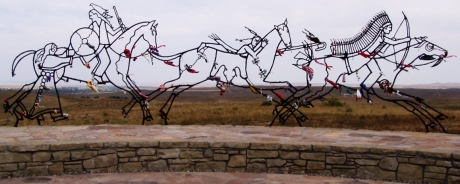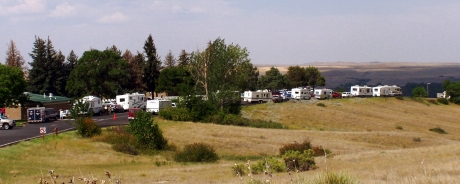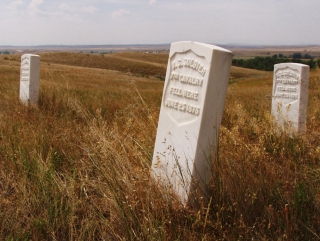NPS Website; Local Website
 WHAT IS IT?
WHAT IS IT?The Site of the infamous and immortalized Last Stand of Lieutenant Colonel George Custer.
BEAUTY (3/10)
Little Bighorn Battlefield looked nothing like what we had always imagined. Michael is not sure why he had always imagined canyons in Montana. The landscape consists only of rolling yellow hills, of which Last Stand Hill is the highest. White gravestones mark the places where the American soldiers fell.
A Little Bighorn Indian Memorial was dedicated in 2003. It is a striking circular design. The monument’s inner walls contain the names of all Indians who died in the fighting. The names are arranged by tribe. The Sioux, Cheyenne and Arapaho are honored next to their enemies in battle, the Crow and the Arikara. Quotes from the survivors accompany the names. A wrought iron Spirit Warriors Sculpture stands in a lowered portion of the circular wall. Many tributes have been tied to the irons. It is a moving memorial.
HISTORICAL INTEREST (4/10)
The interest in Little Bighorn is due to in place in American myth. The Battle is remembered not because it holds any military or historical significance. Unlike the battles along the Bozeman Trail, the Lakota Sioux gained no land and no concessions from their victory. Little Bighorn failed to stop the Montana gold rush. The U.S. Army’s loss did not alter the reservation policy and did not lead to greater military commitment. In five years, by 1881, all Lakota Sioux would be on reservations. By 1889, Montana would be a state. The historical outcome would have been the same regardless of the battle.
Only the Crow Indians may have seen benefit. They aided the U.S. Army as scouts and faced no displacement. They kept their southeast Montana homeland as their reservation. They even got to keep the name. In 1991, Presidential edict changed the Site’s name from Custer Battlefield National Monument to Little Bighorn Battlefield National Monument. The Crows called it Battle of Little Bighorn, the victorious Sioux called it the Battle of the Greasy Grass.
Little Bighorn earned its place in legend because of timing. Custer’s defeat occurred on June 25, 1876, nine days prior to our nation’s gala centennial festivities. News of the battle was strewn across all of the nation’s newspapers. We were celebrating our 100-year birthday, our Manifest Destiny, our unity and our natural growth to be one the world’s great nations. Instead, we learned about an embarrassing and complete defeat to a people we thought were vanquished. As a result, Custer’s Last Stand takes its place in the history books.
 CROWDS (3/10)
CROWDS (3/10)The Site was unbelievably crowded. We happened on Little Bighorn at the same time as the World Famous Crow Fair and Rodeo taking place in the nearby town of Crow Agency. Some of the Battlefield crowd must have been overflow but most seemed unrelated to the Native American festivities.
The parking lot overflowed with Recreational Vehicles. Ranger talks challenged the Park’s bench capacity. Hundreds listened to each lecture. The crowd was mostly retirees. We felt cramped and rushed throughout the Park. The museum was poorly arranged given the tremendous amount of traffic. After ten minutes of fruitlessly trying to look at the exhibits, we left. We skipped the Battlefield Road drive, not willing to crawl down the road between the many RV’s.
EASE OF USE/ACCESS (3/5)
The Battlefield is located less than a mile from Interstate 90, Exit 510. Southeast Montana is remote, regardless of Interstate access. The Site’s parking lot and its museum were not big enough.
CONCESSIONS/BOOKSTORE (3/5)
A good selection of Site-specific books. Thousands of books have been written about Custer’s Last Stand. The Site’s store focuses on these titles.
COSTS (2/5)
Entrance fees are $5 per person, $10 per car. Entry is free with the National Parks Pass.
RANGER/GUIDE TO TOURIST RATIO (4/5)
The Park Rangers do their best to handle the crowds. They give half-hour long lectures every 45 minutes, from 9am until 6pm. Rangers also linger around the patio area during the other talks to ensure that all questions are answered
TOURS/CLASSES (6/10)
We joined the 9:45am The Cavarly Soldier in 1876 lecture just after it had begun. We were transfixed. The Ranger, who identified himself as member of the Crow tribe, was tremendous. His initial aim was to debunk the soldier myths of both western movies and Little Bighorn. “John Wayne would have been much too big to ride a cavalry horse. The U.S. Cavalry had a set weight limit.” He talked about their clothing, saddles and living conditions.
As the crowd grew larger, nearing 100, his talk shifted into discussion about war itself and the necessity for peace. At times, it was hard to distinguish when he was talking about 1876 and the present. Particularly since so many current Special Forces insignias and symbols are derived directly from the Native Guides’ cavalry uniforms he was showing us. The Ranger equally revered the United States and his Crow heritage. He reminded his audience that if they blamed Custer, they must blame the government that sent him to the task.
 We were so excited about his talk that we stayed for the Battle Talk with a new Ranger. It wasn’t nearly as good and we left to walk the Battlefield. We then took the Deep Ravine Trail, self-guided with a 50-cent booklet where we learned that any explanation of what happened during the battle is complete conjecture. There are no reliable witnesses. All of Custer’s men died and the Indian stories vary greatly. We left confused but overall, we did not really care about the specifics of Little Bighorn.
We were so excited about his talk that we stayed for the Battle Talk with a new Ranger. It wasn’t nearly as good and we left to walk the Battlefield. We then took the Deep Ravine Trail, self-guided with a 50-cent booklet where we learned that any explanation of what happened during the battle is complete conjecture. There are no reliable witnesses. All of Custer’s men died and the Indian stories vary greatly. We left confused but overall, we did not really care about the specifics of Little Bighorn.FUN (3/10)
Our fun at Little Bighorn tapered severely after the 9:45am patio talk. Gab is not a big fan of Battlefields, the RV’s were numerous, the crowds large and the history dubious.
WOULD WE RECOMMEND? (3/10)
We wouldn’t, but to us Custer’s Last Stand holds no fascination. The December of 1866 Fetterman Fight a/k/a the Battle of the One-Hundred Slain is much more interesting. Click here for a virtual tour.
It is dissimilar to Little Bighorn only in that it had historical repercussions: travel along the Bozeman Trial was halted and the 1868 Fort Laramie Treaty was signed, giving the Black Hills to the Lakota Sioux and that it did not take on mythic proportion in the East. That Battlefield is located in Wyoming, about 90 miles south of Little Bighorn along Interstate 90 and near Fort Phil Kearny State Historic Site.
TOTAL 34/80
www.usa-c2c.com
© 2004-06